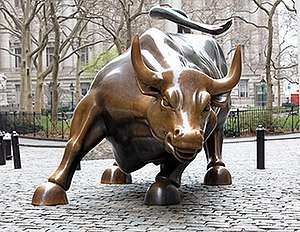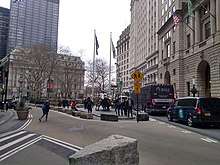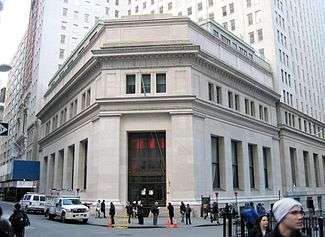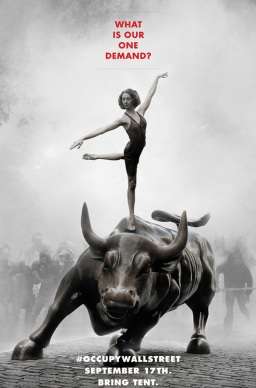Charging Bull
Charging Bull, sometimes referred to as the Wall Street Bull or the Bowling Green Bull, is a bronze sculpture that stands on Broadway just north of Bowling Green in the Financial District of Manhattan, New York City. The 7,100-pound (3,200 kg) bronze sculpture, standing 11 feet (3.4 m) tall and measuring 16 feet (4.9 m) long, depicts a bull, the symbol of aggressive financial optimism and prosperity. Charging Bull is a popular tourist destination that draws thousands of people a day, symbolizing Wall Street and the Financial District.
| Charging Bull | |
|---|---|
 The sculpture in 2020 | |
| Artist | Arturo Di Modica |
| Year | 1989 |
| Medium | Bronze |
| Dimensions | 11 ft × 16 ft (340 cm × 490 cm)[1][2] |
| Weight | 7,100 pounds (3,200 kg) |
| Location | New York City, New York, US |
| 40.705576°N 74.013421°W | |
| Website | Official website |
The sculpture was created by Sicilian artist Arturo Di Modica in the wake of the 1987 Black Monday stock market crash. On December 14, 1989, Di Modica arrived on Wall Street with Charging Bull on the back of a truck and illegally dropped the sculpture outside of the New York Stock Exchange. After being removed by the New York City Police Department later that day, Charging Bull was installed at Bowling Green a week later. Despite initially having only a temporary permit to be located at Bowling Green, Charging Bull became a popular tourist attraction. In 2017, another bronze sculpture titled Fearless Girl was installed across from Charging Bull, though it was later relocated.
Following the success of the original sculpture, Di Modica created a number of variations of the Charging Bull which have been sold to private collectors. Charging Bull has been a subject of criticism from an anti-capitalist perspective, such as in the Occupy Wall Street protests of 2011, and has also been compared to the golden calf worshiped by the Israelites during their Exodus from Egypt.
Description

The 7,100-pound (3,200 kg) sculpture[1] is located in a traffic median of Broadway just north of Bowling Green, adjacent to 26 Broadway to the east and 25 Broadway to the west.[3] It stands 11 feet (3.4 m) tall[1] and measures 16 feet (4.9 m) long.[2] It depicts a bull, the symbol of aggressive financial optimism and prosperity, leaning back on its haunches and with its head lowered as if ready to charge. The sculpture is both a popular tourist destination, which draws thousands of people a day, as well as a symbol of Wall Street and the Financial District, being described as "one of the most iconic images of New York"[4] and a "Wall Street icon".[5]
In Outdoor Monuments of Manhattan: A Historical Guide, Dianne Durante describes the sculpture:
The Bull's head is lowered, its nostrils flare, and its wickedly long, sharp horns are ready to gore; it's an angry, dangerous beast. The muscular body twists to one side, and the tail is curved like a lash: the Bull is also energetic and in motion.[6]
The bronze color and hard, metallic texture of the sculpture's surface emphasizes the brute force of the creature. The work was designed and placed so that viewers could walk around it, which also suggests the creature's own movement is unrestricted — a point reinforced by the twisting posture of the bull's body, according to Durante.
Charging Bull, then, shows an aggressive or even belligerent force on the move, but unpredictably. [...] [I]t's not far-fetched to say the theme is the energy, strength, and unpredictability of the stock market.[6]
Di Modica told the New York Daily News in 1998:
That bull is one of an edition of five. ... I'm hoping the other four will be going to cities all over the world, whenever somebody buys them.[7]
History
Construction and installation

The bull was cast by the Bedi-Makky Art Foundry in Greenpoint, Brooklyn. Di Modica spent $360,000 to create, cast, and install the sculpture following the 1987 stock market crash.[2] The sculpture was Di Modica's idea. Having arrived penniless in the US in 1970, Di Modica felt indebted to America for welcoming him and enabling his career as a successful sculptor. Charging Bull was intended to inspire each person who came into contact with it to carry on fighting through the hard times after the 1987 stock market crash.[8] Di Modica later recounted to art critic Anthony Haden Guest "My point was to show people that if you want to do something in a moment things are very bad, you can do it. You can do it by yourself. My point was that you must be strong".[8]
In an act of guerrilla art, Bedi-Makky Art Foundry and Di Modica trucked it to Lower Manhattan. On December 15, 1989, they installed it beneath a 60-foot (18 m) Christmas tree in the middle of Broad Street in front of the New York Stock Exchange Building as a Christmas gift to New Yorkers. That day, hundreds of onlookers stopped to see it as Di Modica handed out copies of a flier about his artwork.[2]
NYSE officials called police later that day, and the NYPD seized the sculpture and placed it into an impound lot.[2] The ensuing public outcry led the New York City Department of Parks and Recreation to reinstall it two blocks south of the Exchange, in Bowling Green, facing up Broadway just north of Whitehall Street. Charging Bull was rededicated at its new location with a ceremony on December 21, 1989.[9]
Ownership
The sculpture technically has a temporary permit allowing it to stand on city property since the city does not own the sculpture, but the temporary permission has lasted since 1989, when city officials said the new location would not be permanent.[9] Art on loan is usually limited to a year's display, and although the city does not buy art, it does accept donations. By 1993, Di Modica wanted to sell the statue to recover the $320,000 cost of manufacturing it. However, there was only one major bid for the statue: a hotel in Las Vegas that offered $300,000.[10]
A writer in the New York Daily News wrote in 1998 that the statue's placement was "beginning to look a mite permanent".[7] According to an article in Art Monthly, Di Modica, as well as officials and New Yorkers, "view it as a permanent feature of Lower Manhattan".[11] In 2004, Di Modica announced that Charging Bull was for sale, on condition the buyer did not move it from its location.[1][12] The sculpture remained unsold by 2008.[13]
Di Modica continued to own the artistic copyright to the statue,[1] and filed several lawsuits against firms making replicas. For instance, Di Modica sued Wal-Mart and other companies in 2006 for selling replicas of the bull and using it in advertising campaigns.[14][15] Three years later, Di Modica sued Random House for using a photo of the bull on the cover of a book discussing the collapse of financial services firm Lehman Brothers.[16]
Evolution into tourist attraction
As soon as the sculpture was set up at Bowling Green, it became "an instant hit".[10] One of the city's most photographed artworks, it has become a tourist destination in the Financial District. "Its popularity is beyond doubt", a New York Times article said of the artwork. "Visitors constantly pose for pictures around it." [1] Henry J. Stern, the city parks commissioner when the statue first appeared in the Financial District, said in 1993: "People are crazy about the bull. It captured their imagination."[10] Adrian Benepe, a later parks commissioner, said in 2004, "It's become one of the most visited, most photographed and perhaps most loved and recognized statues in the city of New York. I would say it's right up there with the Statue of Liberty."[1] One 2007 newspaper report noted a "ceaseless stream" of visitors from India, the United Kingdom, South Africa, Venezuela, and China, as well as the United States. Children enjoy climbing on the bull,[17] which sits "famously"[6] at street level on the cobblestones at the far northern tip of Bowling Green. A 2003 Bollywood film, Kal Ho Naa Ho, featured Charging Bull in a musical number; one visitor told a reporter that the bull's appearance in the film was a reason for his visit to New York City.[4] Despite the financial crisis of 2007–2008, Charging Bull remained a popular tourist attraction.[13]
In addition to having their pictures taken at the front end of the bull, many tourists pose at the back of the bull, near the large testicles "for snapshots under an unmistakable symbol of its virility".[13] According to a Washington Post article in 2002, "People on The Street say you've got to rub the nose, horns and testicles of the bull for good luck, tour guide Wayne McLeod would tell the group on the Baltimore bus, who would giddily oblige."[18] A 2004 New York Times article said, "Passers-by have rubbed—to a bright gleam—its nose, horns and a part of its anatomy that, as Mr. Benepe put it gingerly, 'separates the bull from the steer.'"[1] A 2007 newspaper account agreed that a "peculiar ritual" of handling the "shining orbs" of the statue's scrotum seems to have developed into a tradition.[4]
On March 7, 2017, a bronze sculpture by Kristen Visbal, Fearless Girl, was installed facing Charging Bull.[19] It was commissioned to advertise for an index fund that comprises gender-diverse companies that have a relatively high percentage of women among their senior leadership and installed in anticipation of International Women's Day the following day. It depicts a girl four foot high, promoting female empowerment.[20] After Di Modica filed complaints about Fearless Girl, it was removed in November 2018 and relocated to outside the New York Stock Exchange. A plaque with footprints was placed on the original site of Fearless Girl.[21]

In November 2019, city officials announced that Charging Bull would be relocated to a plaza outside the New York Stock Exchange due to safety concerns at Bowling Green.[22][23] Officials stated that because Charging Bull is located on a traffic median with large crowds, it was vulnerable to terrorist attacks, citing examples such as the 2017 truck attack on the nearby West Side Highway.[24] Local community group Downtown Alliance supported the relocation, but Di Modica opposed it.[25][26] The New York City Department of Transportation (DOT) had filed an application with the New York City Public Design Commission (PDC) to relocate Charging Bull, but subsequently withdrew the application, which a city spokesperson said was due to uncertainty over the new location.[27][28] Residents of Manhattan Community District 1, which includes the Financial District, expressed opposition to the relocation in a meeting with city officials in May 2020. At the time, updated plans called for Charging Bull to be located at the corner of Broad Street and Wall Street, north of Fearless Girl.[29]
Replicas
In 2010, a similar Charging Bull sculpture by Di Modica was installed in Shanghai on commission by the Shanghai city authority; it is informally called the Bund Bull.[30] Two years later, Di Modica unofficially installed another Charging Bull sculpture outside the Amsterdam Stock Exchange on Beursplein, Amsterdam.[31]
In 2019, Professional Bull Riders authorized Di Modica to craft a scaled replica of Charging Bull as the trophy for the champion of their annual Monster Energy PBR Unleash the Beast bull riding major event, the Monster Energy Buck Off at the Garden major. It was first presented during the 2020 event to João Ricardo Vieira.[32]
Art market
Di Modica created a number of variations of the Charging Bull which have been sold to private collectors. Joe Lewis, who was one time majority owner of Christies, purchased the rest of the original edition. In October 2018 a 6-foot (1.8 m) highly polished bronze version of Charging Bull went to sale at auction at Phillips and sold for $405,000.[33][34] The following March a stainless steel version went on sale at Sotheby's where it sold for $275,000 despite being in poor condition.[35]
Di Modica is officially represented by Geist, an international private art dealership.[36]
Criticism

Charging Bull has often been a subject of criticism from an anti-capitalist perspective. The Occupy Wall Street protests used the bull as a symbolic figure around which to direct their critiques of corporate greed. A 2011 image from Adbusters portraying a dancer posed in an attitude position atop the sculpture was used to promote the forthcoming protests.[37] The first gathering of Occupy took place around the sculpture on September 17, 2011, before moving to Zuccotti Park.[38] Because of the protests, the bull was surrounded by barricades and guarded by police[39] until 2014.[40][41]
The Charging Bull has been likened to the golden calf worshiped by the Israelites during their Exodus from Egypt. During Occupy Wall Street on multiple occasions an interfaith group of religious leaders led a procession of a golden calf figure that was modeled on the bull.[42][43] A large papier-mâché piñata made by Sebastian Errazuriz for a 2014 New York design festival was intended to be reminiscent of both the golden calf and Charging Bull.[44][45] Further comparisons to the golden calf have been made by Jewish and Christian religious commentators.[46][47]
Vandalism
As a prominent symbol of Wall Street and capitalism generally, Charging Bull has been the frequent target of vandalism, particularly as an act of civil disobedience. Shortly after the collapse of Lehman Brothers during the 2008 financial crisis, the bull's scrotum was painted blue.[48] Leading up to a protest on May 12, 2011, the bull was tagged in at least two locations, once again including the scrotum, with the Anarchist "circle-A" iconography, prompting the NYPD to temporarily install barricades around the sculpture.[49] The barriers returned that fall during the Occupy Wall Street protests, and remained in place until March 25, 2014,[50] despite a unanimous resolution from the local community board saying they constituted a hazard to pedestrians.[51]
On September 14, 2017, three months after U.S. president Donald Trump formally announced the United States' withdrawal from the Paris Agreement on climate change, an artist attempting to highlight U.S. popular support for the accord doused the head of the sculpture in a blue pigment.[52][53]
In 2019, Charging Bull was vandalized twice. On September 7, a man from Dallas struck the sculpture with a banjo, leaving a sizable dent in the horn.[54][55] Professional Bull Riders donated money from its ticket sales to pay for fixes to the horn,[56] and Di Modica personally came to the site the following month to repair his creation.[57] Then on October 7, activists from Extinction Rebellion hurled fake blood over the sculpture and staged a die-in on the surrounding traffic plaza.[58]
In popular culture
- The history of the sculpture and its sculptor was presented in the 2014 Italian documentary film Il Toro di Wall Street, released internationally as The Charging Bull.[59]
- In Mr. Robot, Darlene Alderson (Carly Chaikin) is shown castrating the statue.[60][61]
See also
- Art in Odd Places festival
- Big Bull, India, a similar sculpture originally located inside the Bombay Stock Exchange, Mumbai
- CowParade
- Qilin – ancient Chinese symbol of prosperity
- Statue of Edward Snowden – another example of New York guerrilla art
- Market sentiment
References
- Dunlap, David W. (December 21, 2004). "The Bronze Bull Is for Sale, but There Are a Few Conditions". The New York Times. ISSN 0362-4331. Retrieved April 13, 2017.
- Mcfadden, Robert D. (December 16, 1989). "SoHo Gift to Wall St.: A 3 1/2-Ton Bronze Bull". The New York Times. ISSN 0362-4331. Retrieved April 13, 2017.
- "MTA Neighborhood Maps: Bowling Green (4)(5)". mta.info. Metropolitan Transportation Authority. 2018. Retrieved September 13, 2018.
- Pinto, Nick (September 8, 2008). "'Charging Bull,' from Front to Back". Tribeca Trib. Archived from the original on September 8, 2008. Retrieved June 14, 2020.
- Greenfield, Beth; Reid, Robert; Adams Otis, Ginger (2006). New York City. Footscray, Vic. London: Lonely Planet. p. 120. ISBN 978-1-74059-798-2. OCLC 70400334.
- Durante, Dianne L. (February 1, 2007). "5: Charging Bull". Outdoor Monuments of Manhattan: A Historical Guide. NYU Press. ISBN 9780814719862.
- Singleton, Don. "Rock Solid". New York Daily News. Retrieved June 14, 2020.
- "Arturo di Modica: Charging Bull". Phillips.
- The Associated Press (December 20, 1989). "Wall St.'s Bronze Bull Moves 2 Blocks South". The New York Times. ISSN 0362-4331. Retrieved April 13, 2017.
- Lambert, Bruce (October 3, 1993). "Neighborhood Report: Lower Manhattan; A Campaign To Save a Bull". The New York Times. ISSN 0362-4331. Retrieved June 14, 2020.
- Lydiate, Henry (November 1, 2006). "Public sculpture". Art Monthly. Retrieved June 13, 2009 – via Access My Library.
- Milton, Pat (December 21, 2004). "Wall Street bull sculpture for sale". The Seattle Times. Retrieved June 14, 2020.
- Dunlap, David W. (September 16, 2008). "Downtown's Bull, No Longer Emblematic but Still Popular". The New York Times. ISSN 0362-4331. Retrieved June 14, 2020.
- "Sculptor of Manhattan 'Charging Bull' statue sues Wal-Mart, others to protect its image". Associated Press. September 21, 2006. Archived from the original on September 1, 2009. Retrieved July 20, 2007.
- Kennedy, Randy (September 23, 2006). "Arts, Briefly; Sculptor Files Lawsuit Against Wal-Mart". The New York Times. ISSN 0362-4331. Retrieved June 14, 2020.
- "Suit Alleges Illegal Use of `Charging Bull' Image". Los Angeles Times. From Dow Jones/the Associated Press. September 22, 2006. Retrieved March 9, 2017.
- Sommers, Carl (May 26, 1991). "Q and A". The New York Times. ISSN 0362-4331. Retrieved June 14, 2020.
- Duke, Lynn, "The Pilgrimage To Ground Zero — Officials and Tourists Walk A Fine Line on Solemn Ground", Washington Post, February 27, 2002, Edition F, page C1, accessed via newsbank.com subscription archive website (also on High Beam Research subscription archive website) on May 4, 2008
- Wiener-Bronner, Danielle (March 7, 2017). "Why a defiant girl is staring down the Wall Street bull". CNNMoney. Retrieved March 7, 2017.
- Bekiempis, Victoria (November 28, 2018). "New York: Fearless Girl who faced down Wall Street's bull moved to new spot" – via www.theguardian.com.
- Moyer, Liz (November 28, 2018). "'Fearless Girl' on the move, but leaves footprints for visitors to stand in her place". CNBC. Retrieved November 28, 2018.
- "NYC Plans to Move Charging Bull Statue". NBC New York. November 7, 2019. Retrieved June 14, 2020.
- Stevens, Pippa (November 7, 2019). "Wall Street's 'Charging Bull' sculpture is moving". CNBC. Retrieved June 14, 2020.
- Blint-Welsh, Tyler; Chapman, Ben (November 7, 2019). "New York's 'Charging Bull' Statue Will Soon Move From Longtime Corral". Wall Street Journal. ISSN 0099-9660. Retrieved June 14, 2020.
- Paybarah, Azi (November 11, 2019). "Should the Charging Bull Statue Be Moved?". The New York Times. ISSN 0362-4331. Retrieved June 14, 2020.
- "The Artist Behind Wall Street's 'Charging Bull' Is Seeing Red Over a Plan to Remove the Sculpture From the Financial Hub". artnet News. November 19, 2019. Retrieved June 14, 2020.
- Kim, Elizabeth (November 13, 2019). "City Delays Moving Charging Bull". Gothamist. Retrieved June 14, 2020.
- Marsh, Julia (November 13, 2019). "De Blasio reins in plans to move NYC's Charging Bull statue". New York Post. Retrieved June 14, 2020.
- Small, Zachary; Small, Zachary (May 22, 2020). "New York's Iconic 'Charging Bull' Sculpture Becomes Subject of Fierce Debate Among Politicians". ARTnews.com. Retrieved June 14, 2020.
- Areddy, James. "Shanghai Gets a Bull for Its Own Shop". wsj.com. Retrieved May 10, 2019.
- "Bronzen stier op Beursplein" [Bronze Bull on stock exchange square]. Nu NL news (in Dutch). July 5, 2012. Archived from the original on November 2, 2014. Retrieved June 13, 2020.
- Giangola, Andrew. "Charging Bull artist creates new trophy for PBR in New York". Professional Bull Riders. Endeavor. Retrieved January 3, 2020.
- "Arturo di Modica - Charging Bull". Phillips. Retrieved January 31, 2020.
- "Reserve Collection │ Tavistock Restaurant Collection". Tavistock Restaurant Collection. Retrieved January 31, 2020.
- http://www.sothebys.com/en/auctions/ecatalogue/lot.316.html/2019/contemporary-curated-n10027
- "About | Geist Modern Contemporary". geistmc.com.
- Beeston, Laura (October 11, 2011). "The Ballerina and the Bull: Adbusters' Micah White on 'The Last Great Social Movement'". The Link. Retrieved October 12, 2011.
- Pepitone, Julianne. "Hundreds of protesters descend to 'Occupy Wall Street'". CNNMoney. Retrieved April 14, 2017.
- Harshbarger, Rebecca; Rosario, Frank (December 27, 2011). "Outrage over caged Wall Street bull". New York Post. Retrieved June 14, 2020.
- DeGregory, Priscilla; Harshbarger, Rebecca (March 25, 2014). "Free market: Barricades around Wall Street Bull go down". New York Post. Retrieved June 14, 2020.
- Badia, Erik; McShane, Larry (March 26, 2014). "Freedom! Barricade around Wall Street 'Charging Bull' comes down". New York Daily News. Retrieved June 14, 2020.
- Schaper, Donna (October 11, 2011). "Occupy Wall Street, The Golden Calf And The New Idolatry". Huffington Post. Retrieved April 14, 2017.
- Rieger, J (2013). Religion, Theology, and Class: Fresh Engagements after Long Silence. Springer. p. 114. ISBN 1137339241.
- Cascone, Sarah (May 27, 2014). "Anti-Capitalist Golden Cow Piñata Sculpture Rains Cash in Brooklyn". Artnet. Retrieved April 14, 2017.
- "SI_BULL". www.meetsebastian.com. Retrieved April 14, 2017.
-
- Badcock, Gary D. (2016). God and the Financial Crisis: Essays on Faith, Economics, and Politics in the Wake of the Great Recession. Cambridge Scholars Publishing. p. 11. ISBN 9781443888370. Retrieved April 12, 2017. *Myers, Robin (2012). The Underground Church: Reclaiming the subversive way of Jesus. New York: SPCK. ISBN 9780281069422. Retrieved April 12, 2017. *Susen, Simon; Turner, Bryan S. (2014). The Spirit of Luc Boltanski: Essays on the ‘Pragmatic Sociology of Critique’. Anthem Press. p. 460. ISBN 1783082976. Retrieved April 12, 2017. *Gushee, David P.; Stassen, Glen H. (2016). Kingdom Ethics, 2nd ed.: Following Jesus in Contemporary Context (2nd ed.). Wm. B. Eerdmans Publishing. p. 373. ISBN 9780802874214. Retrieved April 12, 2017.
- "Why I'm Not Bullish On 'Fearless Girl'". The Forward. Retrieved April 14, 2017.
- Chung, Jen (October 8, 2008). "Wall Street Really Needs Relief". Gothamist. Retrieved June 13, 2020.
- Chung, Jen (May 12, 2011). "Wall Street Bull's Balls Painted With Anarchy Symbols". Gothamist. Retrieved June 13, 2020.
- DeGregory, Priscilla; Harshbarger, Vanessa (March 25, 2014). "Free market: Barricades around Wall Street Bull go down". New York Post. Retrieved June 13, 2020.
- Dabellis, Dakota (July 2, 2012). "Barriers at Wall Street area's 'Charging Bull' are dangerous: community board". New York Post. Retrieved June 13, 2020.
- Whitford, Emma (September 14, 2014). "Wall Street Bull Splashed With Blue Paint To Protest Climate Change Denial". Gothamist. Retrieved June 13, 2020.
- Wattles, Jackie (September 16, 2014). "Woman arrested for vandalizing Wall Street's famed bull statue". CNN Money. Retrieved June 13, 2020.
- "Man vandalizes iconic Wall Street Charging Bull landmark with a banjo, police say". ABC7 New York. September 8, 2019. Retrieved January 31, 2020.
- Syckle, Katie Van; Southall, Ashley (September 8, 2019). "Attack Leaves Wall Street's Iconic Bull With a Gash on Its Horn". The New York Times. ISSN 0362-4331. Retrieved June 14, 2020.
- Fitz-Gibbon, Jorge (September 11, 2019). "Bull-riding group wants to help pay for 'Charging Bull' statue's repair". New York Post. Retrieved June 14, 2020.
- Iconic Charging Bull Sculpture Getting Repair After Attack, retrieved January 31, 2020
- "Global climate protests: Activists pour fake blood on famous Wall Street bull". USA TODAY. Retrieved January 31, 2020.
- MYmovies.it. "The Charging Bull - The Bull of Wall Street". MYmovies.it (in Italian). Retrieved February 22, 2018.
- "'Mr. Robot': Everything That Happened in Season 2". Retrieved March 20, 2019.
- "'Mr. Robot' Season 2 Premiere Recap ‖ Hollywood Reporter". Retrieved March 20, 2019.
External links
